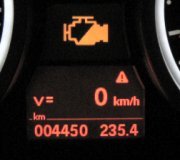The 641 code is related to the other code as well. It has to do with a 5 volt reference voltage to the accelerator position sensor, which is the gas pedal.
You need to check the voltage at the sensor and see if you have this 5 volt signal at that sensor as well as the crank sensor as well.
Roy
Circuit/System Description
The engine control module (ECM) has 2 internal 5-volt reference busses called 5-volt reference 1 and 5-volt reference 2. Each reference bus provides 5-volt reference circuits for more than one sensor. Therefore, a fault condition on one 5-volt reference circuit will affect the other 5-volt reference circuits connected to that reference bus. The ECM monitors the voltage on the 5-volt reference busses.
The 5-volt reference 1 bus provides 5 volts to the following sensors:
* The manifold absolute pressure (MAP) sensor
* The fuel tank pressure (FTP) sensor
* The air conditioning (A/C) refrigerant pressure sensor
* The accelerator pedal position (APP) sensor 2
* The intake camshaft position (CMP) sensor
The 5-volt reference 2 bus provides 5 volts to the following sensors:
* The APP sensor 1
* The throttle position (TP) sensor 1 and 2
* The crankshaft position (CKP) sensor
Conditions for Running the DTC
* DTCs P0601, P0602, P0603, P0604, P0605, P0606, P0607, and P2610 are not set.
* The ignition is in Unlock, Accessory, Run, or Crank.
* The ignition voltage is more than 5.23 volts.
* DTCs P0641 and P0651 run continuously when the above conditions are met.
Conditions for Setting the DTC
The ECM detects a voltage out of tolerance condition on the 5-volt reference 1 or 2 bus for more than 0.5 second.
Action Taken When the DTC Sets
DTCs P0641 and P0651 are Type A DTCs.
Conditions for Clearing the MIL/DTC
DTCs P0641 and P0651 are Type A DTCs.
Diagnostic Aids
It may be possible to locate the fault by disconnecting one component at a time from the 5-volt reference circuit while viewing the 5-Volt Reference circuit parameter on the scan tool. The scan tool parameter would change from Fault to OK when the source of the fault is disconnected.
If all 5-volt reference components have been disconnected and a Fault is still indicated, the fault may exist in the wiring harness.
Circuit/System Verification
With the ignition ON and the engine OFF, observe the 5-volt Reference 1 and 2 parameters. The scan tool should display 4.3-4.7 volts for a normally operating system.
Circuit/System Testing
Important: Additional DTCs will set when disconnecting the components.
1. Ignition OFF, disconnect the harness connector of all appropriate sensors for the applicable DTC.
Important: A short to voltage on the signal circuit of certain components may cause this DTC to set.
2. Ignition ON, measure for 4.8-5.2 volts between one of the 5-volt reference circuits and ground.
If the voltage is less than the specified value, test for a short to ground on all the 5-volt reference circuits. If all circuits test normal, replace the control module.
If the voltage is greater than the specified value, test for a short to voltage on all the 5-volt reference circuits, or the signal circuit, for each component associated with the appropriate 5-volt reference circuit. If all circuits test normal, replace the control module.
3. Connect each component associated with the 5-volt reference circuit, one at a time, while monitoring the voltage. The voltage should not change more than 1 volt.
If the voltage display changes more than the specified value when a component is connected, replace the component.
Repair Instructions
* Accelerator Pedal Position Sensor Replacement
* Air Conditioning (A/C) Refrigerant Pressure Sensor Replacement
* Control Module References for ECM replacement, setup, and programming
* Fuel Tank Pressure Sensor Replacement
* Manifold Absolute Pressure Sensor Replacement
* Throttle Body Assembly Replacement
* Camshaft Position Sensor Replacement - Intake
* Crankshaft Position Sensor Replacement
Repair Verification
With the ignition ON and the engine OFF, observe the 5-Volt Reference 1 and 2 parameters. The scan tool should display 4.3-4.7 volts for a normally operating system.
Thursday, February 8th, 2018 AT 1:53 AM





